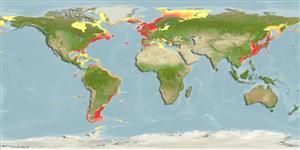Common names from other countries
Classification / Names / Names
Nomes comuns | Sinônimos | Catalog of Fishes (gen., sp.) | ITIS | CoL | WoRMS
Environment: milieu / climate zone / depth range / distribution range
Ecologia
; estuarina; intervalo de profundidade 0 - 590 m (Ref. 415). Tropical
Northwest Pacific, Atlantic Ocean, Mediterranean, Antarctic and Arctic Ocean: Iberian Peninsula and Belize. Tropical and subtropical.
Length at first maturity / Tamanho / Peso / Idade
Maturity: Lm ? range ? - ? cm Max length : 3.0 cm TL macho/indeterminado; (Ref. 415)
Found in rock crevices, mangrove root mats and mud, along subtidal and intertidal zones in marine and brackish environments (Ref. 415). Known to be an osconformer, which is unaffected by large and repeated changes in salinity, but is known to be affected by increases in water temperature (Ref. 86624). Known as a benthic species (Ref. 85346). Intertidal to 590 m in rock crevices; mangrove roots mats and mud (Ref. 415); 34 to 500 m both in Ionian and North Aegean Sea (Ref. 775). Infaunal, burrows (Ref. 116123). This species is collected from mangrove and Thalassia root mats (Ref. 86591).
Collin, R., M.C. Díaz, J. Norenburg, R.M. Rocha, J.A. Sánchez, M. Schulze, A. Schwartz and A. Valdés. 2005. (Ref. 415)
Status na Lista Vermelha da IUCN (Ref. 130435)
Status no CITES (Ref. 108899)
Not Evaluated
Not Evaluated
Uso pelos humanos
| FishSource |
Ferramentas
Mais informação
Nomes comunsSinônimosPredadoresReproduçãoMaturidadeDesovaFecundidadeOvosDesenvolvimento dos ovos
Idade/Tamanho
Crescimento
Comprimento-peso
Comprimento-comprimento
Morfologia
Larvas
Abundância
Fontes da internet
Estimates based on models
Preferred temperature
(Ref.
115969): 3.4 - 22, mean 8.5 (based on 1568 cells).
Vulnerabilidade
Low vulnerability (10 of 100).
Categoria de preço
Unknown.
